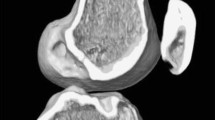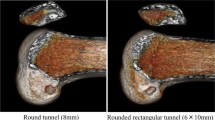Abstract
Purpose
The first purpose of this study was to examine whether fluoroscopic-based navigation system contributes to the accuracy and reproducibility of the bone tunnel placements in single-bundle anterior cruciate ligament (ACL) reconstruction. The second purpose was to investigate the application of the navigation system for double-bundle ACL reconstruction.
Methods
A hospital-based case–control study was conducted, including a consecutive series of 55 patients. In 37 patients who received single-bundle ACL reconstruction, surgeries were performed with this system for 19 knees (group 1) and without this system for 18 knees (group 2). The positioning of the femoral and tibial tunnels was evaluated by plain sagittal radiographs. In 18 patients who received double-bundle ACL reconstruction using the navigation system (group 3), the bone tunnel positions were assessed by three-dimensional computed tomography (3D-CT). Clinical assessment of all patients was followed with the use of Lysholm Knees Score and IKDC.
Results
Taking 0% as the anterior and 100% as the posterior extent, the femoral tunnels were 74.9 ± 3.0% in group 1 and 71.5 ± 5.8% in group 2 along Blumensaat’s line, and the tibial tunnels were 42.3 ± 1.4% in group 1 and 42.5 ± 4.6% in group 2 along the tibia plateau. The bone tunnel positions in group 1 were located significantly closer to the position planned preoperatively and varied less in both femur and tibial side, compared with those without navigation (group 2). (Femur: P < 0.05, Tibia: P < 0.001) 3D-CT evaluation of double-bundle ACL reconstruction (group 3) also demonstrated that the bone tunnel positions of both anteromedial (AM) and posterolateral (PL) were placed as we expected.
Conclusion
The fluoroscopic-based navigation system contributed to the more reproducible placement of the bone tunnel during single-bundle ACL reconstruction compared with conventional technique. Additionally, this device was also useful for double-bundle ACL reconstruction.
Level of evidence
Case–control study, Therapeutic study, Level III.




Similar content being viewed by others
References
Aglietti P, Giron F, Losco M, Cuomo P, Ciardullo A, Mondanelli N (2010) Comparison between single-and double-bundle anterior cruciate ligament reconstruction: a prospective, randomized, single-blinded clinical trial. Am J Sports Med 38:25–34
Almekinders LC, Chiavetta J (2001) Tibial subluxation in anterior ligament-deficient knees: implications for tibial tunnel placement. Arthroscopy 17:960–962
Amis AA, Jakob RP (1998) Anterior cruciate ligament graft positioning, tensioning and twisting. Knee Surg Sports Traumatol Arthrosc 6(Suppl 1):S2–S12
Behrend H, Stutz G, Kessler MA, Rukavina A, Giesinger K, Kuster MS (2006) Tunnel placement in anterior cruciate ligament (ACL) reconstruction: quality control in a teaching hospital. Knee Surg Sports Traumatol Arthrosc 14:1159–1165
Bernard M, Hertel P, Hornung H, Cierpinski T (1997) Femoral insertion of the ACL. Radiographic quadrant method. Am J Knee Surg 10:14–22
Bicer EK, Lustig S, Servien E, Selmi TA, Neyret P (2010) Current knowledge in the anatomy of the human anterior cruciate ligament. Knee Surg Sports Traumatol Arthrosc 18:1075–1084
Burkart A, Debski RE, McMahon PJ (2001) Precision of ACL tunnel placement using traditional and robotic techniques. Comput Aided Surg 6:270–278
Cheng T, Liu T, Zhang G, Zhang X (2011) Computer-navigated surgery in anterior cruciate ligament reconstruction: are radiographic outcomes better than conventional surgery? Arthroscopy 27:97–100
Faul F, Erdfelder E, Lang AG et al (2007) G*power 3: a flexible statistical power analysis program for social, behavioral, and biomedical sciences. Behav Res Methods 39:175–191
Foley KT, Simon DA, Rampersaud YR (2001) Virtual fluoroscopy: computer-assisted fluoroscopic navigation. Spine 26:347–351
Fu FH, Jordan SS (2007) The lateral intercondylar ridge-a key to anatomic anterior cruciate ligament reconstruction. J Bone Joint Surg Am 89:2103–2104
Halbrecht J, Levy IM (1993) Fluoroscopic assist in anterior cruciate ligament reconstruction. Arthroscopy 9:533–535
Hantes ME, Liantsis AK, Basdekis GK, Karantanas AH, Christel P, Malizos KN (2010) Evaluation of the bone bridge between the bone tunnels after anatomic double-bundle anterior cruciate ligament reconstruction: a multidetector computed tomography study. Am J Sports Med 38:1618–1625
Hart R, Krejzla J, Svab P, Kocis J, Stipcak V (2008) Outcomes after conventional versus computer-navigated anterior cruciate ligament reconstruction. Arthroscopy 24:569–578
Howell SM, Taylor MA (1993) Failure of reconstruction of the anterior cruciate ligament due to impingement by the intercondylar roof. J Bone Joint Surg Am 75:1044–1055
Iriuchishima T, Ingham SJ, Tajima G, Horaguchi T, Saito A, Tokuhashi Y, Van Houten AH, Aerts MM, Fu FH (2010) Evaluation of the tunnel placement in the anatomical double-bundle ACL reconstruction: a cadaver study. Knee Surg Sports Traumatol Arthrosc 18:1226–1231
Ishibashi Y, Tsuda E, Fukuda A, Tsukada H, Toh S (2006) Future of double-bundle anterior cruciate ligament (ACL) reconstruction: incorporation of ACL anatomic data into the navigation system. Orthopedics 29:S108–S112
Jaureguito JW, Paulos LE (1996) Why grafts fail. Clin Orthop Relat Res 325:25–41
Kasten P, Szczodry M, Irrgang J, Kropf E, Costello J, Fu FH (2010) What is the role of intra-operative fluoroscopic measurement to determine tibial tunnel placement in anatomical anterior cruciate ligament reconstruction? Knee Surg Sports Traumatol Arthrosc 18:1169–1175
Kamath GV, Redfern JC, Greis PE, Burks RT (2011) Revision anterior cruciate ligament reconstruction. Am J Sports Med 39:199–217
Khadem R, Yeh CC, Sadeghi-Tehrani M (2000) Comparative tracking error analysis of five different optical tracking systems. Comput Aided Surg 5:98–107
Khalfayan EE, Sharkey PF, Alexander AH, Bruckner JD, Bynum EB (1996) The relationship between tunnel placement and clinical results after anterior cruciate ligament reconstruction. Am J Sports Med 24:335–341
Klos TV, Habets RJ, Banks AZ, Banks SA, Devilee RJ, Cook FF (1998) Computer assistance in arthroscopic anterior cruciate ligament reconstruction. Clin Orthop Relat Res 354:65–69
Landis JR, Koch GG (1977) The measurement of observer agreement for categorical data. Biometrics 33:159–174
Lane CG, Warren RF, Stanford FC, Kendoff D, Pearle AD (2008) In vivo analysis of the pivot shift phenomenon during computer navigated ACL reconstruction. Knee Surg Sports Traumatol Arthrosc 16:487–492
Nakagawa T, Hiraoka H, Fukuda A (2007) Fluoroscopic-based navigation-assisted placement of the tibial tunnel in revision anterior cruciate ligament reconstruction. Arthroscopy 23:441–444
Nakagawa T, Takeda H, Nakajima K (2008) Intraoperative 3-dimensional imaging-based navigation-assisted anatomic double-bundle anterior cruciate ligament reconstruction. Arthroscopy 24:1161–1167
Pietrini SD, Ziegler CG, Anderson CJ, Wijdicks CA, Westerhaus BD, Johansen S, Engebretsen L, LaPrade RF (2011) Radiographic landmarks for tunnel positioning in double bundle ACL reconstructions. Knee Surg Sports Traumatol Arthrosc 19:792–800
Plaweski S, Cazal J, Rosell P, Merloz P (2006) Anterior cruciate ligament reconstruction using navigation: a comparative study on 60 patients. Am J Sports Med 34:542–552
Purnell ML, Larson AI, Clancy W (2008) Anterior cruciate ligament insertions on the tibia and femur and their relationships to critical bony landmarks using high-resolution volume-rendering computed tomography. Am J Sports Med 36:2083–2090
Seon JK, Gadikota HR, Wu JL, Sutton K, Gill TJ, Li G (2010) Comparison of single- and double-bundle anterior cruciate ligament reconstructions in restoration of knee kinematics and anterior cruciate ligament forces. Am J Sports Med 38:1359–1367
Shino K, Suzuki T, Iwahashi T (2010) The resident’s ridge as an arthroscopic landmark for anatomical femoral tunnel drilling in ACL reconstruction. Knee Surg Sports Traumatol Arthrosc 18:1164–1168
Snow M, Stanish WD (2010) Double-bundle ACL reconstruction: how big is the learning curve? Knee Surg Sports Traumatol Arthrosc 18:1195–1200
Song EK, Seon JK, Park SJ, Hur CI, Lee DS (2009) In vivo laxity of stable versus anterior cruciate ligament-injured knees using a navigation system: a comparative study. Knee Surg Sports Traumatol Arthrosc 17:941–945
Staubli HU, Rauschning W (1994) Tibial attachment area of the anterior cruciate ligament in the extended knee position. Anatomy and cryosections in vitro complemented by magnetic resonance arthrography in vivo. Knee Surg Sports Traumatol Arthrosc 2:138–146
Taketomi S, Nakagawa T, Takeda H, Nakajima K, Nakayama S, Fukai A, Hirota J, Kachi Y, Kawano H, Miura T, Fukiu N, Nakamura K (2011) Anatomical placement of double femoral tunnels in anterior cruciate ligament reconstruction: anteromedial tunnel first or posterolateral tunnel first? Knee Surg Sports Traumatol Arthrosc 19:424–431
Tensho K, Kodaira H, Yasuda G, Yoshimura Y, Narita N, Morioka S, Kato H, Saito N (2011) Anatomic double-bundle anterior cruciate ligament reconstruction, using CT-based navigation and fiducial markers. Knee Surg Sports Traumatol Arthrosc 19:378–383
Topliss C, Webb J (2001) An audit of tunnel position in anterior cruciate ligament reconstruction. Knee 8:59–63
Tsukada H, Ishibashi Y, Tsuda E, Fukuda A, Toh S (2008) Anatomical analysis of the anterior cruciate ligament femoral and tibial footprints. J Orthop Sci 13:122–129
Vergis A, Gillquist J (1995) Graft failure in intra-articular anterior cruciate ligament reconstructions: a review of the literature. Arthroscopy 11:312–321
Voos JE, Musahl V, Maak TG, Wickiewicz TL, Peale AD (2010) Comparison of tunnel positions in single-bundle anterior cruciate ligament reconstructions using computer navigation. Knee Surg Sports Traumatol Arthrosc 18:1282–1289
Zantop T, Wellmann M, Fu FH, Petersen W (2008) Tunnel positioning of anteromedial and posterolateral bundles in anatomic anterior cruciate ligament reconstruction: anatomic and radiographic findings. Am J Sports Med 36:65–72
Acknowledgments
The authors would like to thank Ms. Janina Tubby and Mr. Daniel Gilpin for help in preparing the manuscript. No benefits in any form have been received or will be received from a commercial party related directly or indirectly to the subject of this article, nor have any funds been received in support of this study.
Author information
Authors and Affiliations
Corresponding authors
Rights and permissions
About this article
Cite this article
Kawakami, Y., Hiranaka, T., Matsumoto, T. et al. The accuracy of bone tunnel position using fluoroscopic-based navigation system in anterior cruciate ligament reconstruction. Knee Surg Sports Traumatol Arthrosc 20, 1503–1510 (2012). https://doi.org/10.1007/s00167-011-1726-3
Received:
Accepted:
Published:
Issue Date:
DOI: https://doi.org/10.1007/s00167-011-1726-3




